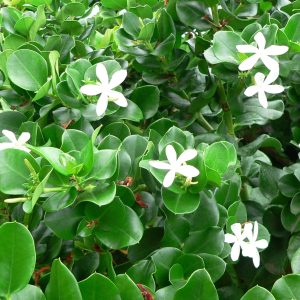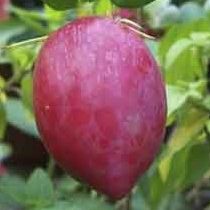Carissa macrocarpa
Carissa, Natal plum
Origin
It is native to the coastal region of southern Africa, where it is a traditional food plant, a useful, ornamental hedge and a source of firewood and medicines. It is now distributed across Africa and warm regions of the world.
Climate
Carissa is subtropical to near-tropical, and can survive temperatures as low as 3°C.
Plant Description
It is a variably spiny plant with a gummy white sap which can be pruned as a hedge or shrub, or allowed to become a straggly tree, up to 5m tall, with a tendency to spread on other plants. The leathery glossy evergreen leaves are opposite and ovate, 2.5-5cm long.
Relatives
Apocynaceae Family. There are a few relatives with edible fruits, including several Australian natives which are used as bush tucker, such as C. spinarum. However, these should only be eaten if they are totally ripe. The white latex and unripe fruits are poisonous. C. carandas is an Indian relative.
Soils
It will grow in a range of soil types provided it is well-drained.
Propagation
Carissa is easy to propagate from seeds, but the preferred way is vegetative. Young branches can be notched and bent downwards, and left for several months until a callus is formed. Then remove the cutting from the parent and put in sand in a shady spot until roots form.
Cultivars
Gifford, Fancy, Torrey Pines, Frank, Chesley and Serena, among others. There are also dwarf varieties available, with correspondingly smaller fruit.
Flowering and Pollination
The starry, white, sweetly fragrant flowers are 5-lobed and occur at the tips of branches either singly or as a few. Flowers are perfect but on some plants they may function as male with stamens longer than the style. The stamens in functionally female flowers are the same length as the style but have no pollen. Hence, plants tend to be classified as dioecious, and cross-pollination of the different types can assist fruit set. Normal pollination is by night-flying insects such as beetles and hawk moths, but bees and hand pollination can also assist.
Cultivation
Carissa tolerates both full sun and shade. It withstands salty ocean spray well. Young plants need protection if the temperature drops below -2°C. Carissas are slow-growing but very hardy and drought resistant. Although they can survive drought, they’ll be better producers if provided with water during flowering and fruiting.
Wind Tolerance
Good.
Pruning
It benefits from pruning to keep it controlled and to stimulate denser growth with more fruiting tips, hence more fruit. In an orchard situation, it is best grown in narrow rows to facilitate the harvesting of fruits growing on the tops of the bushes.
The Fruit
Berries are round or oval, up to 6cm long and 4cm wide. Skin colour changes from green to bright red crimson with a whitish bloom when mature. The strawberry-coloured pulp is juicy with a milky sap and encloses 6-15 small edible brown seeds. Many improved cvs have large plum-sized fruit but seedling fruit are usually much smaller. Vitamin C content is equivalent to citrus and carbohydrate levels are 10-15%. The flavour is tart and the inside of the fruit is filled with white latex.
Fruit Production and Harvesting
Handle fruit gently while harvesting, as they bruise easily and are highly perishable.
Fruit Uses
The whole fruit can be eaten fresh when slightly soft to the touch. If fruits are lightly steamed, the latex disappears and a ruby-red, delicious juice can be pressed out and when sweetened, makes a wonderful jelly or jam, wine, vinegar and various desserts. The latex can adhere to the cooking pot: do not use aluminium pots.
Pests and Diseases
Mites, scales, thrips, various bacterial, viral and fungal infections.
Comments
It makes excellent hedges, with the fruit as a bonus. Different plants can have small thorns of various lengths and these can help make hedges an effective green fence.

